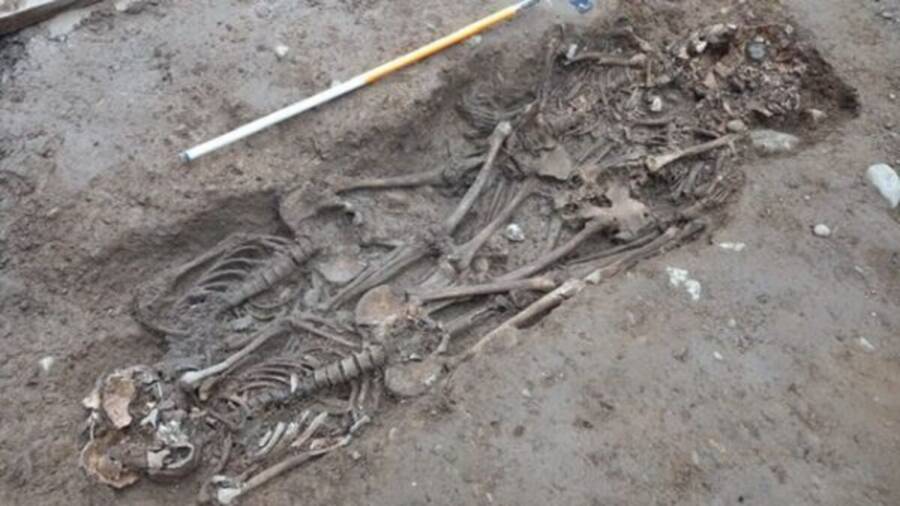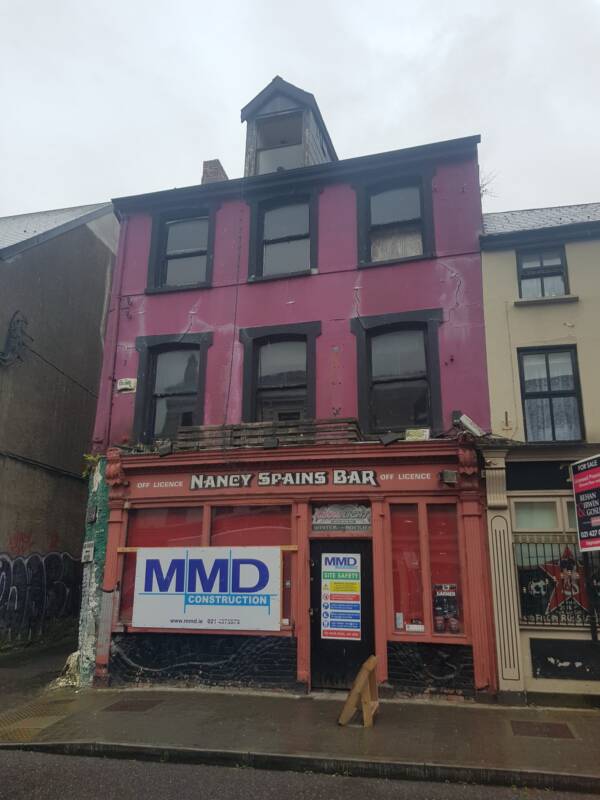The remains of six men discovered beneath Nancy Spain's bar in Cork, Ireland, likely died violently between 1447 and 1636.

Cork City CouncilThe men appear to have died during a turbulent period in Irish history.
For years, young people flocked to Nancy Spain’s pub in Cork, Ireland, at 48 Barrack Street, to drink and enjoy music. But the whole time, they were dancing atop bones. When the pub was demolished in 2021, archeologists came across centuries-old skeletons of six men who’d met “violent” ends as long as 500 years ago.
“It was very exciting to find the bones,” David Murphy, a senior archaeologist with John Cronin and Associates who first spotted the bones, told the Irish Examiner. “It doesn’t happen every day and you want to make sure you follow the proper procedures.”
Murphy and other archaeologists first came across the remains during the demolition of the pub in October 2021. When they spotted the skeletons, they notified the authorities. But it quickly became clear that the men buried beneath Nancy Spain’s bar had died a long time ago.
“The area is part of what was the suburbs of medieval Cork and so is in a zone of archaeological potential,” Murphy told the Irish Examiner.
According to The Journal, radiocarbon dating revealed that the men had died between 1447 and 1636. They were all between 18 and 25 at the time of their deaths, and it appeared that they’d each met “a violent and gruesome end.”

John Cronin & AssociatesThe burial site where archeologists dug up the skeletons.
The bodies, osteo-archaeologist Niamh Daly told the Irish Examiner, were not put to rest in “a respectful manner.” Rather, then men were bound and then dumped into a mass grave, where they were buried “head to toe.”
“In fact, it was evident that all four individuals were buried in a manner which suggests that the hands and/or wrists were bound behind the backs,” Daly said, “and it is likely that the feet and/or ankles were also bound.”
However, archaeologists aren’t entirely sure how the men died. The Irish Examiner notes that the men appeared to have been healthy — aside from some plaque on their teeth — at the time of their death.
Indeed, the team didn’t find evidence of trauma to their bones, suggesting that the men were not hanged, shot with arrows, butchered with axes, knives, or swords, or shot with a gun.
So how did the men die — and why? The archaeologists have some theories. According to The Journal, a number of historic events took place in Ireland between 1447 and 1636 that could explain their gruesome deaths.

TwitterNancy Spain’s bar shortly after it closed, and before archeologists found skeletons buried beneath it.
The Journal writes that they could have perished during the First Desmond Rebellion (1569 – 1573), the Second Desmond Rebellion (1579 – 1583), the Nine Years War (1593 – 1603), or during a revolt in Cork in 1603 following the death of Queen Elizabeth I.
“It is hoped that ongoing post-excavation work will provide greater clarity and accuracy on [the] burial date of the revealed individuals,” the Cork City Council said in a statement, as reported by The Journal. Then, it might be easier to align the men’s death with any of the historical events that swept Cork over the centuries.
But the skeletons of the six men weren’t the only thing that archaeologists found under Nancy Spain’s pub.
According to the Irish Examiner and The Journal, they also found evidence of a large ditch that dates back to the 11th or 12th century, a period when the descendants of indigenous Irish people and Vikings started developing Cork. City archaeologist Ciara Brett called the discovery “highly significant.”
“This area formed part of the suburbs of the medieval city and is therefore of important historical and archaeological significance,” she told the Irish Examiner. “The ditch, which is exceptionally large in size, was not known about prior to excavation.”
Murphy added that the ditch could offer new clues about the early development of Cork itself.
“The presence of this defensive ditch feature, some 300 [meters] upslope and to the southwest of the accepted area of settlement, may suggest that the settlement was more extensive than previously thought,” he said, noting that it could have also been purely defensive in nature and set apart from the original settlement.
As for the bodies found under Nancy Spain’s pub? Archaeologists say that the investigation is ongoing and that they hope to learn more about the lives and deaths of the men buried there.
“The story won’t end here,” Daly told the Irish Examiner. “With advances in technology, the bones may be subjected to further study and analysis using new techniques in the future, and who knows what those tests may discover.”
After reading about the bodies found under an Irish pub, look through these photos of the “Troubles” in Ireland. Or, see how archeologists found an “exceptionally high” number of decapitated Roman-era skeletons in England.





